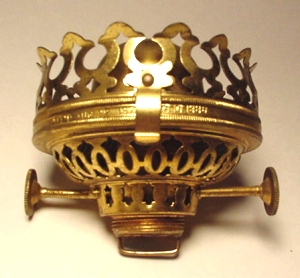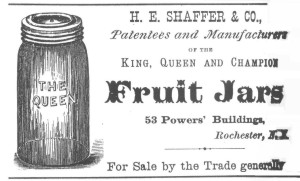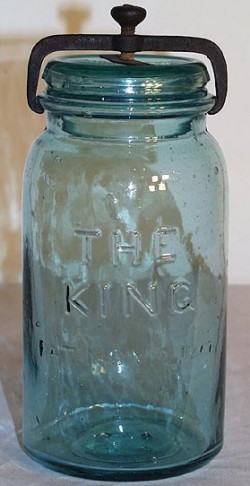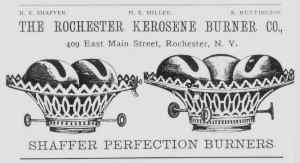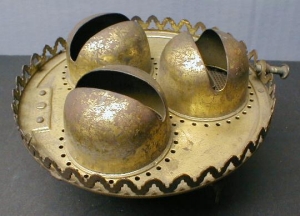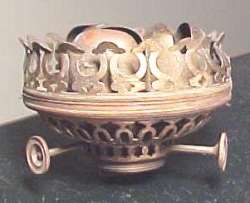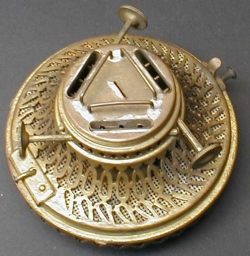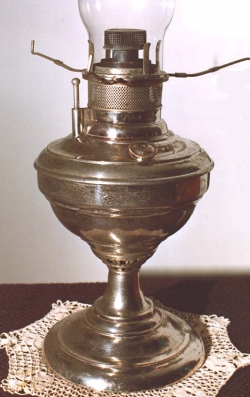Henry E. Shaffer was a prominent figure in the Rochester fruit jar trade. As early as 1869 he was listed in the Rochester City Directory as a manufacturer of fruit jars.2 In the 1866-1871 city directories, William S. Thompson was listed as an importer and dealer in glass, crockery & china, kerosene lamps and oil. His address was 51 State Street. In 1869, The Henry E. Shaffer & Co. was listed at the same address with Thompson as an associate. An advertisement in the May 3, 1869 edition of the Rochester Daily Union and Advertiser for Henry E. Shaffer & Co. lists the firm as selling Wilcox, Hero, Gem and other fruit jars, with an office at Wm. S. Thompson's Crockery Store, 51 State Street.3 In 1872 and 1873 the city directory lists Shaffer as selling fruit jars.4
On December 12, 1871, Shaffer helped organize The Consolidated Fruit Jar Company with Lewis R. Boyd, John L. Mason, Stephen R. Pinckney, William S. Carr, and Henry C. Wisner. The firm grew out of an effort to "combine their respective interests and business for their mutual benefit, to bring together all the property used by them in a destructive business rivalry, and to consolidate the same into one organization." The company was incorporated on December 16, 1871.6 The earliest known place of business was as 66 Warren Street, New York City, New York. On May 1, 1872 they moved to 49 Warren Street. During this time, and until ca. 1875, Henry E. Shaffer is listed as the secretary and treasurer of the company.7 By 1885, Henry E Shaffer was fully established in the lighting business as advertisements for his lamp wares appeared in the Crockery and Glass Journal that year.8 The company went through a number of changes in the mid- to late 1880's. These changes are chronicled in the Rochester City Directories9 from the period. The 1885 directory has the following listing for Shaffer: "Shaffer Henry E. lamps, house 724 E. Main". The only advertisement for the company (reproduced below) appears in the 1886 directory.
In 1887 the company name was changed from The Rochester Kerosene Burner Company to Shaffer, Miller & Huntington Burner Mfg.10 The 1887 directory no longer lists the Rochester Kerosene Burner Company. It has been replaced with a listing for "Shaffer, Miller and Huntington, kerosene burners, 409 E. Main." There is no advertisement.
In 1888, the listing for "Shaffer, Miller and Huntington" has been dropped and there is only a listing for "Shaffer Henry E. pres. 409 E. Main, h. 724 do." A short-lived partnership to be sure! According to the Industries of the City of Rochester, published in 1888, the company, now called The Rochester Burner Company, is located at 409 East Main Street and occupies one floor and the basement and employs ten men. The officers are listed as: H.E. Shaffer, President; H.F. Peck, Vice-president; E.A. Roworth, Secretary and Treasurer.11 Shaffer's 1888 patent is assigned to the Rochester Burner Company. This directory listing continues until at least 1890. The 1891 and 1892 issues were not available for review. The 1893 directory lists "Shaffer Henry E. house 6 College Avenue." Henry Shaffer's three patents obtained during 1895 and 1896 are assigned to the Shaffer Lamp Company, which appears to have been the final incarnation of the business after Shaffer, Miller & Huntington and The Rochester Burner Company.
The PERFECTION Burner was manufactured in both two and three flatwick configurations. Each configuration was made in two versions: one that took a regular slip chimney and one that utilized a lip chimney. The top of the burner on the lip version is hinged like a SUN burner and fastens to the burner body with a spring tab. The hinge is similar to a Marcy type hinge. The chimney is secured with one set screw. The version that takes a slip chimney has a removable deck or deflector that is secured by a tab/slot on one side and a spring clip on the opposite side. This deflector is not hinged and can be totally removed. An excerpt from the 1888 H. Leonard & Sons Catalogue, 13
The Perfection Burners all use common flat wicks, either
No. 1 or 2, are simple in construction, and as easy to
trim and take care of a any common flat wick burner.
The No. 1, 3-Cone Burner, takes No. 1 wick and the
regular No. 2 Sun Chimney. The No. 2 Burners (either 2
or 3 cone) take the No. 2 flat wick and the Shaffer's
Perfection Chimney.
Per doz.
No. 1, 3-Cone Perfection Burner fits No. 2 Collar.......5.04
No. 2, 2-Cone Perfection Burner fits No. 2 Collar.......5.04
No. 2, 3-Cone Perfection Burner fits No. 3 Collar.......6.30
Also from the 1888 H. Leonard & Sons Catalogue, 14
SHAFFER CHIMNEYS,
10 per cent less in original barrels
Open per doz.
No. 2 Shaffer Chimney, for 2 cone burner, plain........ 1.25
No. 2 Shaffer Chimney, for 2 cone burner, ground....... 1.50
No. 3 Shaffer Chimney, for 3 cone burner, plain........ 1.25
No. 3 Shaffer Chimney, for 3 cone burner, ground....... 1.50
 Henry E. Shaffer's Patents Henry E. Shaffer's Patents
To view any of the above patents, enter the number in the box below and select Query USPTO Database. This will take you to the specific patent images on the U.S. Patent & Trademark Office Database. Learn more about the USPTO here. End Notes & References
| ||||||||||||||||||||||||||||||||||||||||||||||||||||||||||||||||||||||||||||
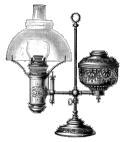
| Reference Desk | Lamp Information | Other Resources | On-Line Shopping |

Purveyors of Antique Lighting and Accessories
435 Main Street
 Hurleyville, New York 12747
Hurleyville, New York 12747
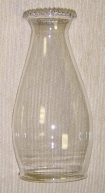 The Shaffer Chimney
The Shaffer Chimney--------------------- Enlarge image [+] |
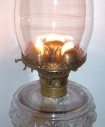 The Triple Perfection
The Triple PerfectionIn all it's Splendor! Photo: Fil Graff --------------------- Enlarge image [+] |
 Shaffer's No. 94,248
Shaffer's No. 94,248for the jar closure. August 31, 1869 Photo: Greg Spurgeon --------------------- Enlarge image [+] |
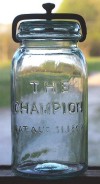 THE CHAMPION jar
THE CHAMPION jarAugust 31, 1869 Photo: Greg Spurgeon --------------------- Enlarge image [+] |
a brief historical profile of

The Rochester Kerosene Burner Company
^ Top of Page
Privacy Policy | Terms and Conditions of Use | Announcements
Copyright © 2001-2011 ~ Daniel Edminster | The Lampworks ~ All Rights Reserved
